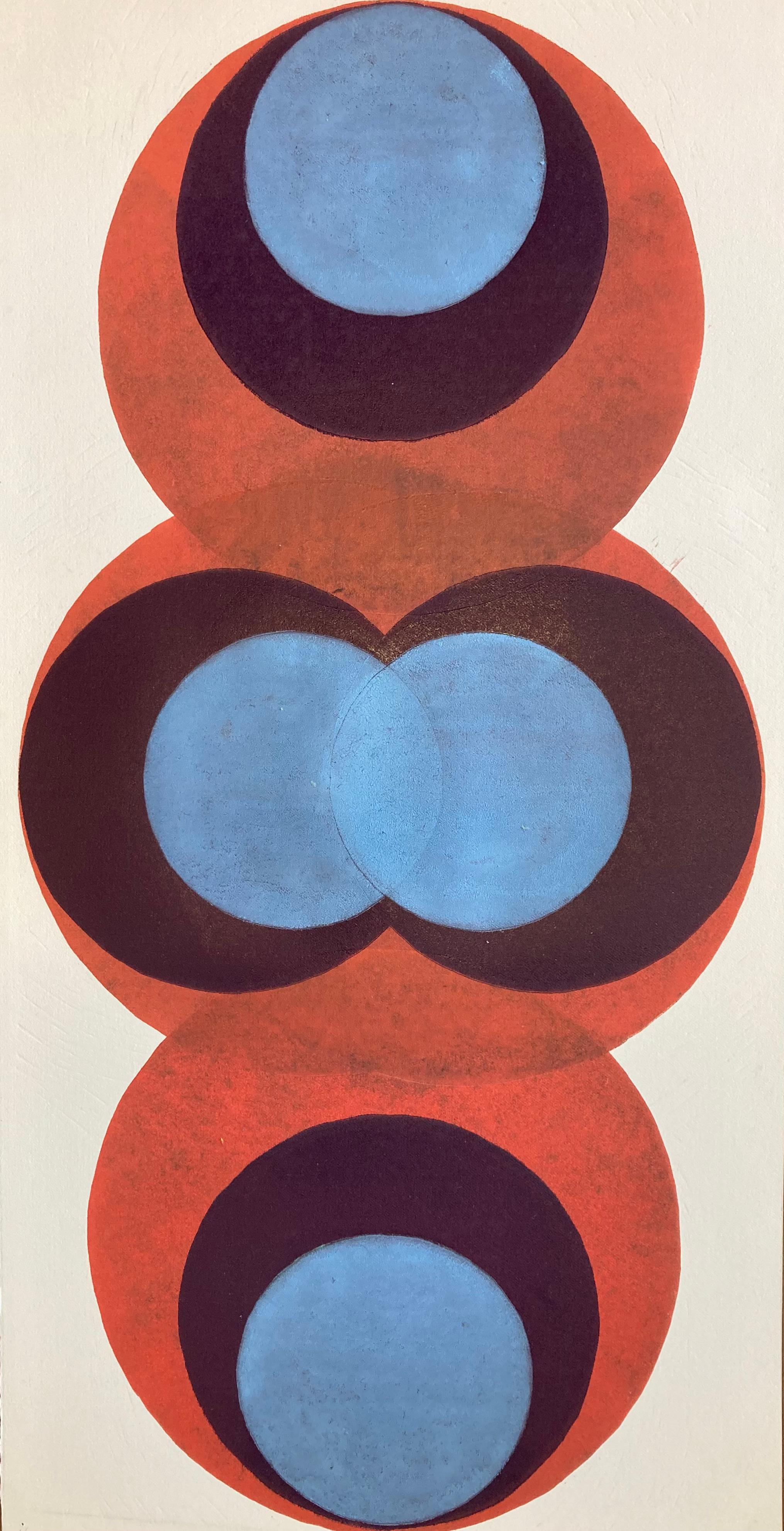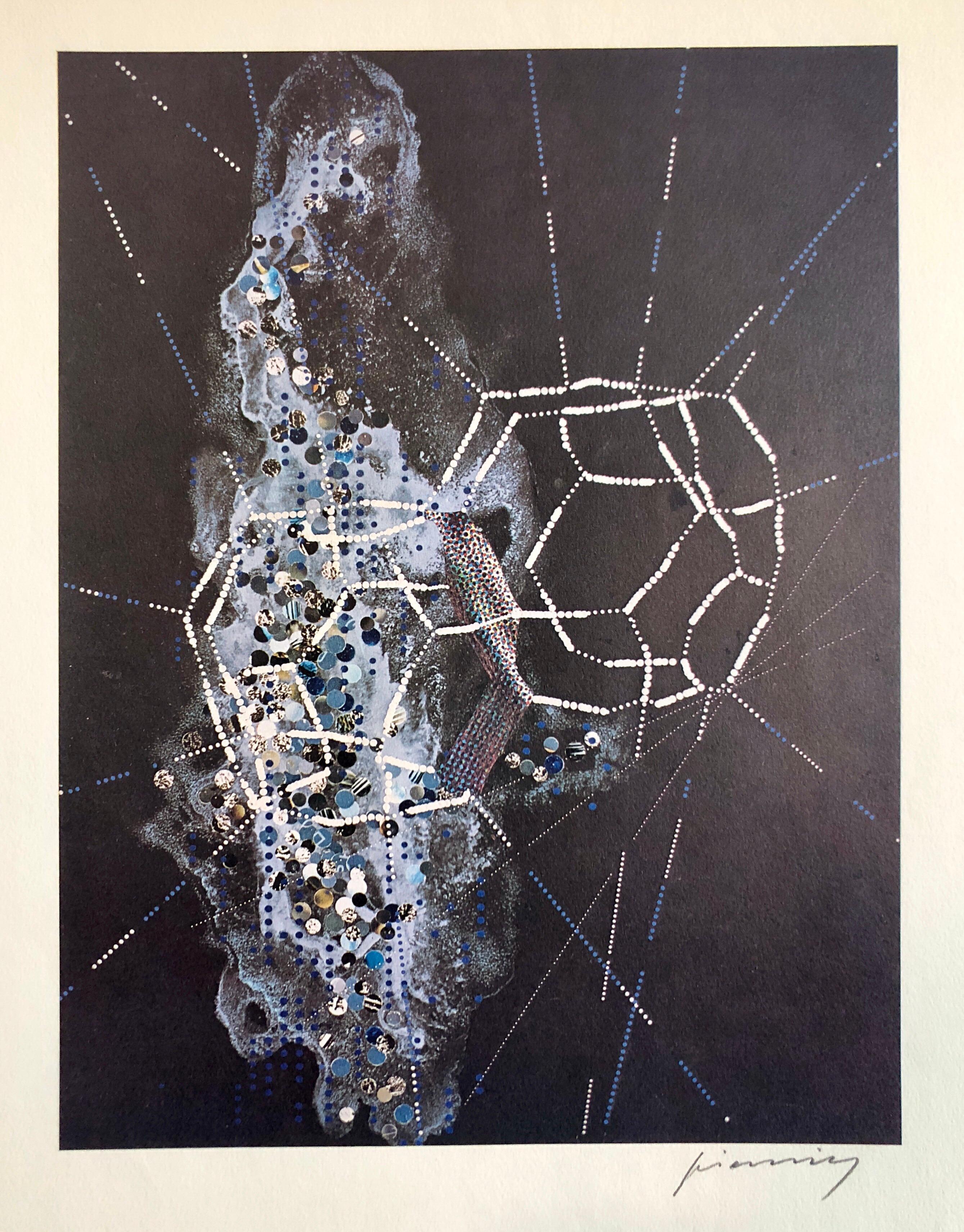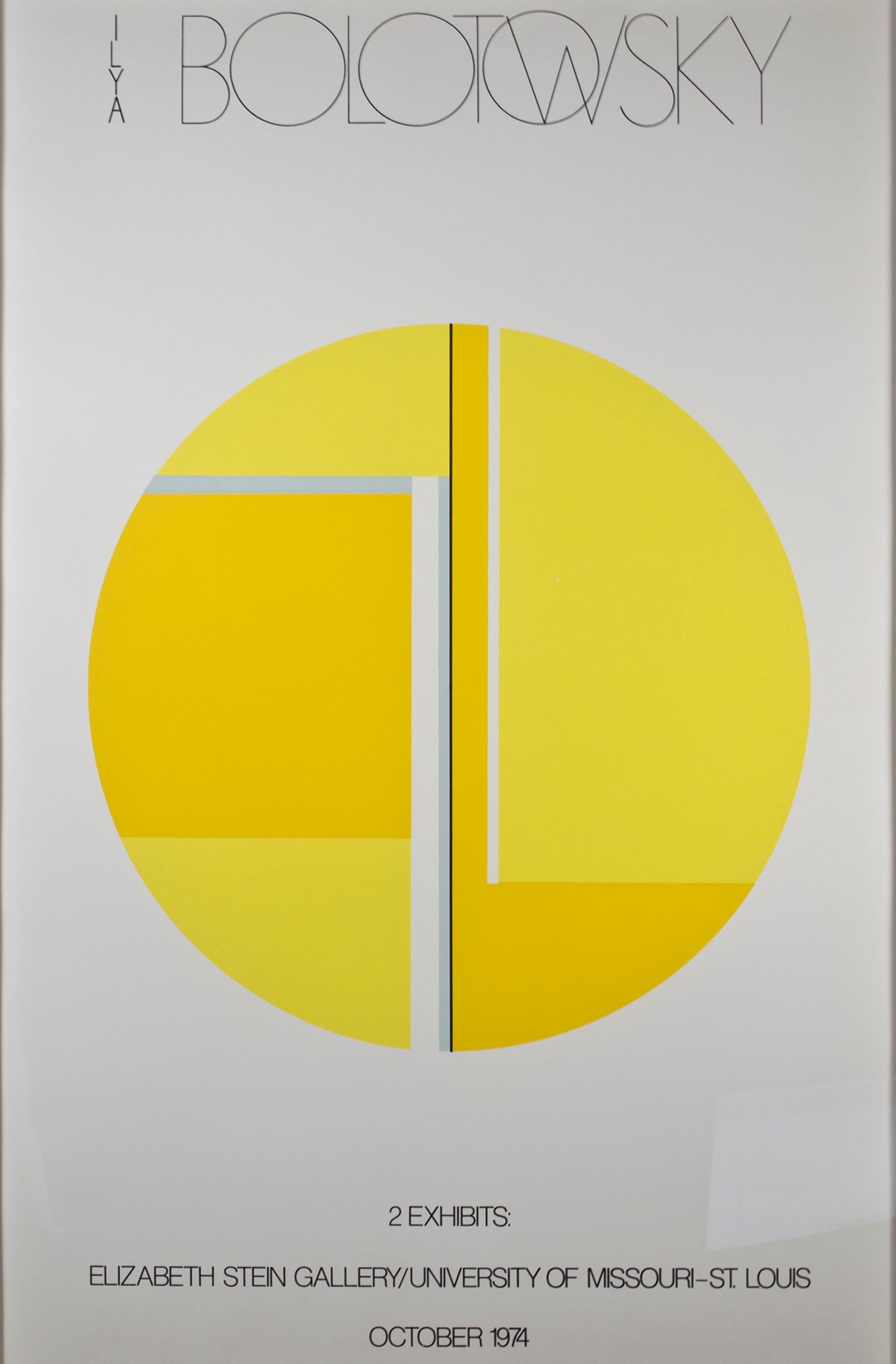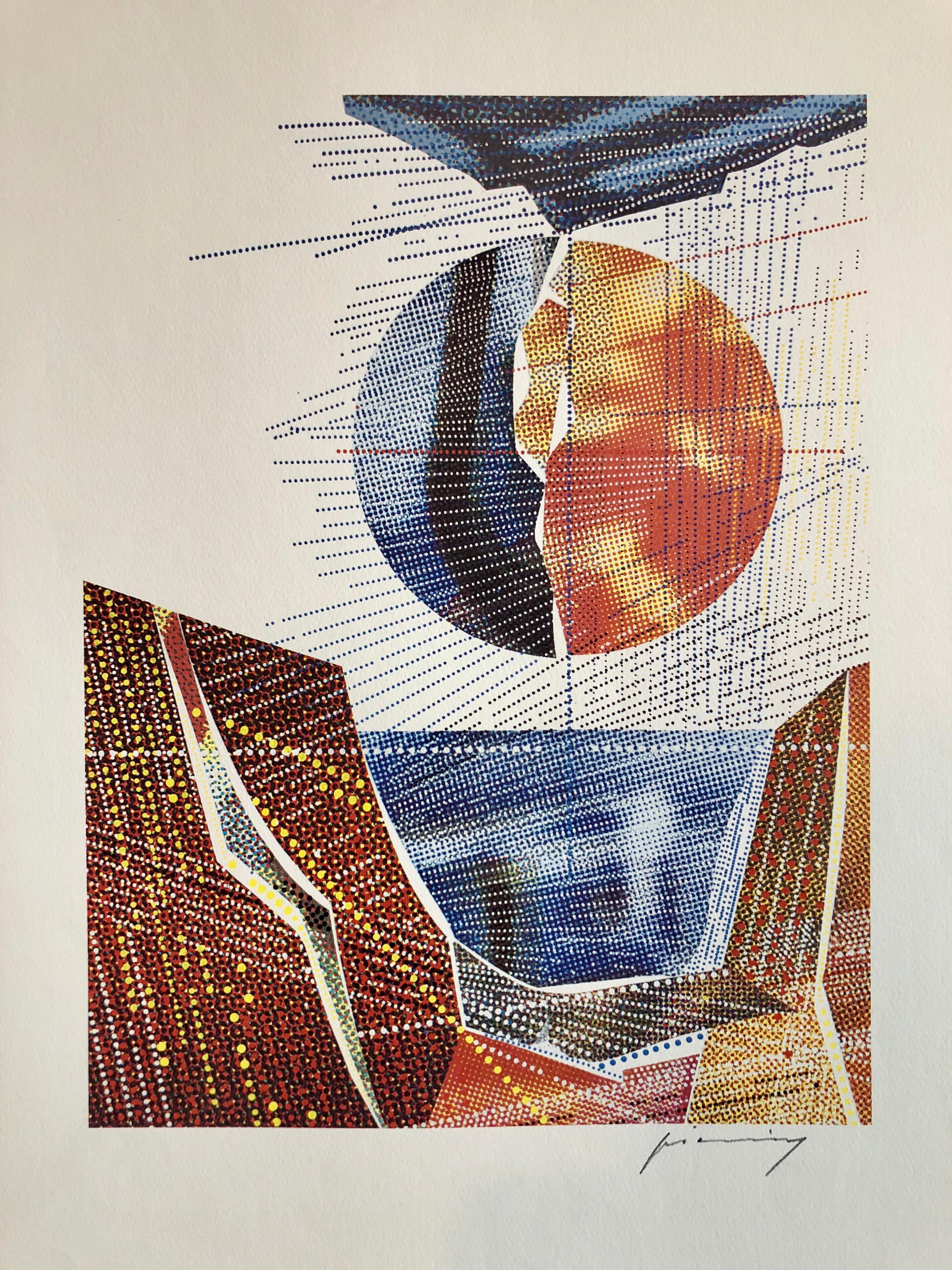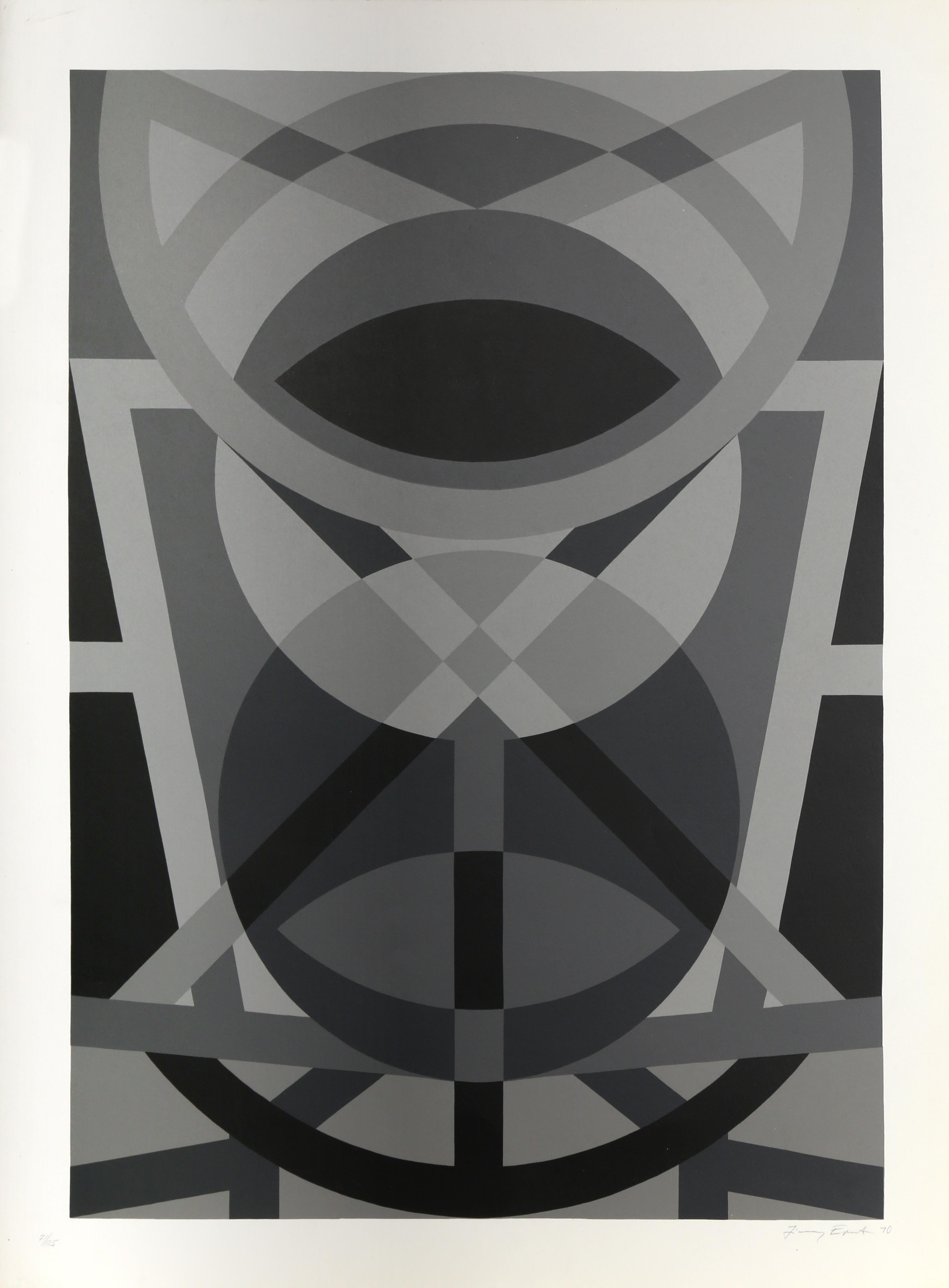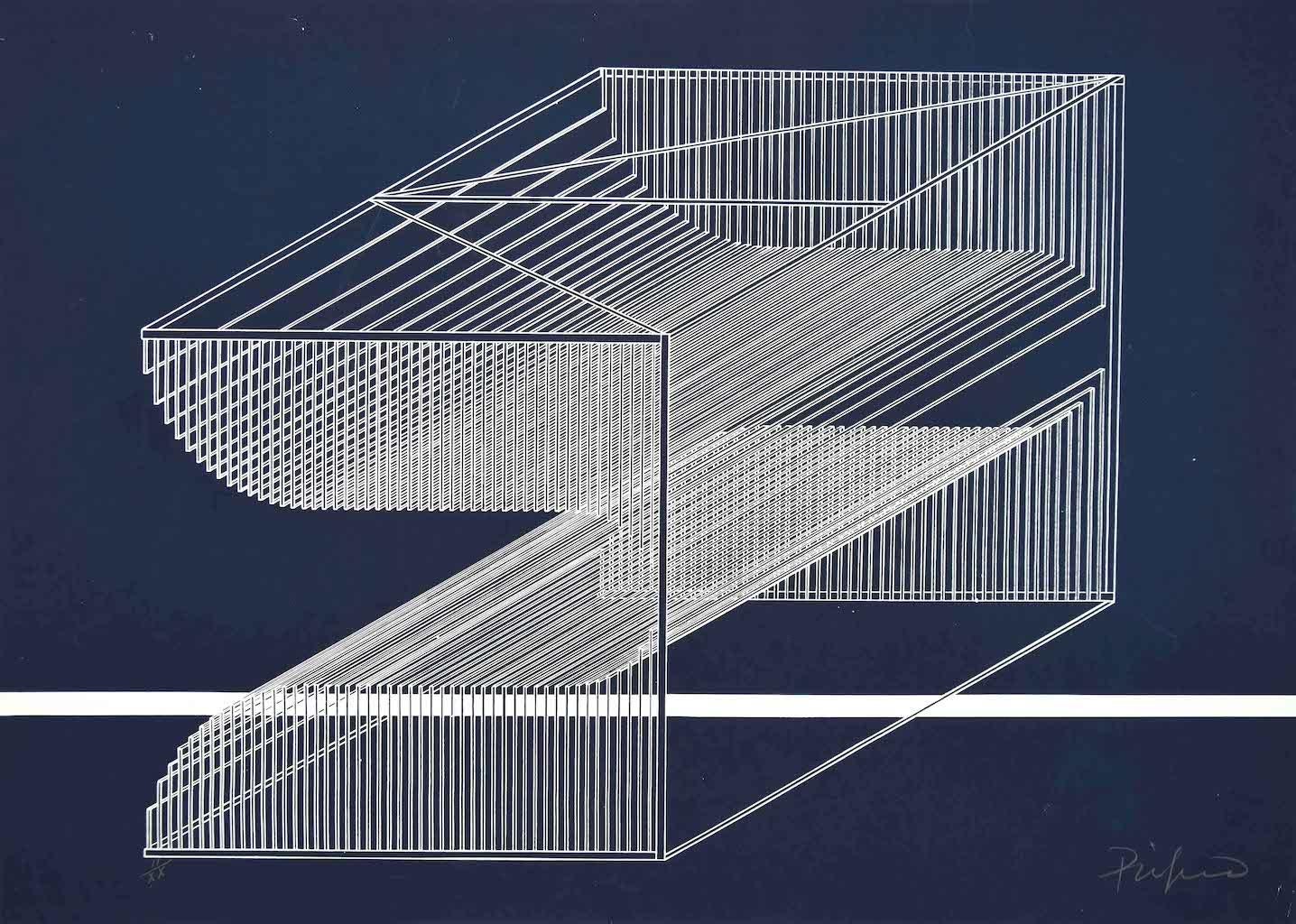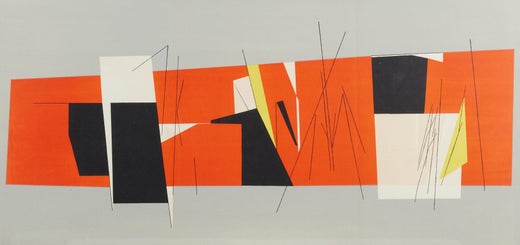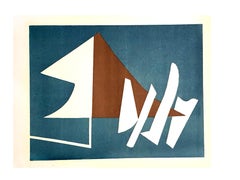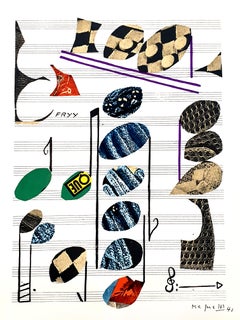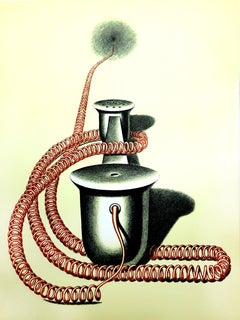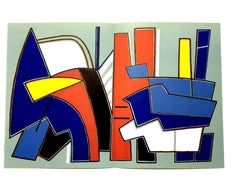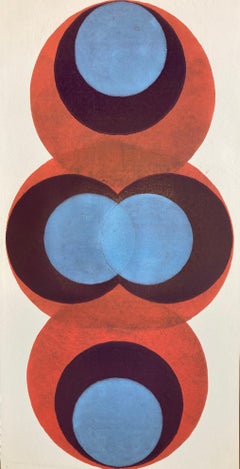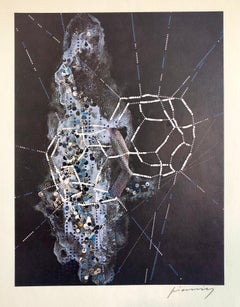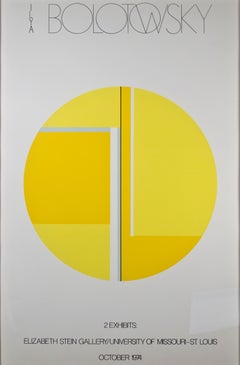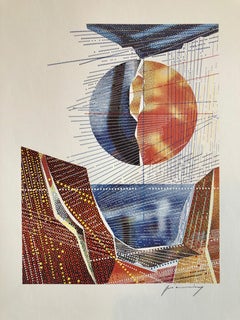Items Similar to Pablo Palazuelo - Original Lithograph
Want more images or videos?
Request additional images or videos from the seller
1 of 6
Pablo PalazueloPablo Palazuelo - Original Lithograph1976
1976
$838.02
£626.70
€700
CA$1,154.75
A$1,259.80
CHF 667.06
MX$15,096.05
NOK 8,495.37
SEK 7,768.38
DKK 5,331.33
About the Item
Pablo Palazuelo - Original Lithograph
1976
Dimensions: 32 x 25 cm
Revue XXe Siècle
Edition: Cahiers d'art published under the direction of G. di San Lazzaro.
Pablo Palazuelo
B. 1916, MADRID; D. 2007, MADRID
Pablo Palazuelo was born on October 8, 1916, in Madrid. When he was just ten years old, a portrait painter created a pastel depicting him with his sister, making a great impression on him and instilling a strong interest in drawing and painting. Palazuelo began studying architecture in Madrid in 1932 and later at the School of Arts and Crafts, Oxford, England (1934–36). While there he became familiar with the Tecton group of architects (1932–48) and the work of artists such as Jacob Epstein and Duncan Grant. He took the Intermediate Exams of the Royal Institute of British Architects before the Spanish Civil War began in 1936, and he returned to serve as a pilot in the Spanish army.
Palazuelo decided not to return to England and began to devote much time to painting, exhibiting at the Galería Buchholz, Madrid, in 1945 alongside members of the young Madrid School. In 1946 or 1947 he became enamored with Paul Klee’s work, specifically his interest in geometry and abstract geometric forms found in nature. Juan Gris, Pablo Picasso, and Daniel Vázquez Díaz, who was Palazuelo’s painting instructor in the late 1940s, also influenced his early abstracted still lifes. However, by 1948, Palazuelo had eliminated all figuration in his paintings, pursuing purely abstract forms. He exhibited his first abstract work in the inaugural Salon de Mai, Paris, in 1949. In 1948, aided by a French government grant, he had moved to Paris, where he would remain until 1969, coming into contact with artists associated with Galerie Maeght, where he had his first solo exhibition in 1955 and continued to exhibit until the 1980s. His 1950s work delved deeper into abstract form, as he explored Arabic and Eastern thought, particularly the musical rhythms of Islamic art, infinity, and the notion of the “active imagination.” In 1953–54, he participated in Younger European Painters: A Selection at the Guggenheim Museum.
Between 1954, with his first sculpture in melted bronze, Ascendant, and 1962, he gradually began creating work in three dimensions, and in the 1970s working specifically with open and closed polygonal shapes. In 1969 he returned to Spain and settled in his family’s home close to San Lorenzo de El Escorial. He developed his foundational themes of inner conscience, imagination, and transmutation in public works such as Lauda II for Madrid’s Barajas Airport, and his mural for the foyer of the Picasso Tower, Madrid, in 1990.
Palazuelo participated in the Pittsburgh International (now Carnegie International, 1955), as well as exhibitions at Galería Juana Mordó, Madrid (his first Spanish exhibition, 1964), and Musée des beaux-arts, Chaux-de-Fonds, Switzerland (1970). The Museo nacional centro de arte Reina Sofía, Madrid, presented a major retrospective of his work (1995) with a further expansion of the show a decade later. The most recent Palazuelo retrospective was co-organized by Museu d’art contemporani de Barcelona in conjunction with the Guggenheim Museum Bilbao (2005–06). He received numerous awards, including the Kandinsky Prize (1952); Carnegie Prize from Carnegie Museum of Art, Pittsburgh (1958); and the Medalla de Oro al Mérito en las Bellas Artes, awarded by the Spanish Ministry of Culture (1982). Palazuelo died on October 3, 2007, in Madrid.
- Creator:Pablo Palazuelo (1915 - 2007, Spanish)
- Creation Year:1976
- Dimensions:Height: 12.6 in (32 cm)Width: 9.85 in (25 cm)Depth: 0.04 in (1 mm)
- Medium:
- Movement & Style:
- Period:
- Condition:
- Gallery Location:Collonge Bellerive, Geneve, CH
- Reference Number:1stDibs: LU16123489271
Pablo Palazuelo
Pablo Palazuelo was one of the most significant Spanish abstract artists of the 20th century. He originally studied architecture at the University of Oxford but soon turned to visual arts. His work focused deeply on geometry, transformation, and the spiritual dimension of form. In 1948, he received a grant from the French Institute and moved to Paris, where he engaged with avant-garde circles and became influenced by geometric abstraction, Eastern philosophy, and alchemy. Style and Work: Early influences include Paul Klee and Bauhaus theory.
In the 1950s, he developed what he called “geometric transformations”, using abstract forms to explore metaphysical ideas.
From 1969 onward, he expanded into sculpture, giving three-dimensional form to his visual language.
He also created prints and worked on artist’s books. Awards and Recognition: Kandinsky Prize (1952)
Spain’s National Prize for Plastic Arts (1999)
Gold Medal for Merit in the Fine Arts (2004) Legacy: Palazuelo's work is held in major institutions such as the Museo Reina Sofía (Madrid), MACBA (Barcelona), and numerous international collections. He is celebrated for blending science, mysticism, and art through his unique abstract language.
About the Seller
4.9
Gold Seller
Premium sellers maintaining a 4.3+ rating and 24-hour response times
Established in 2015
1stDibs seller since 2015
972 sales on 1stDibs
Typical response time: 1 hour
- ShippingRetrieving quote...Shipping from: Collonge Bellerive, Geneve, Switzerland
- Return Policy
More From This Seller
View AllAlberto Magnelli - Composition - Original Lithograph
By Alberto Magnelli
Located in Collonge Bellerive, Geneve, CH
Alberto Magnelli
Composition
Lithograph
Conditions: excellent
32 x 24 cm
1951
Executed for XXe siècle
Published by San Lazzaro, Paris
Unsigned and unnumbered as issued
Category
1950s Abstract Geometric Abstract Prints
Materials
Lithograph
After Alberto Magnelli - Sorlier Lithograph
By Alberto Magnelli
Located in Collonge Bellerive, Geneve, CH
Alberto Magnelli (After)
Lithograph, Charles Sorlier
32 x 24 cm
1971
XXe siècle, San Lazzaro
Signed in the plate
Unumbered as issued
Category
1970s Abstract Geometric Abstract Prints
Materials
Lithograph
Konrad Klapheck - Original Lithograph
By Konrad Klapheck
Located in Collonge Bellerive, Geneve, CH
Konrad Klapheck - Original Lithograph
1976
Dimensions: 32 x 25 cm
Revue XXe Siècle
Edition: Cahiers d'art published under the direction of G. di San Lazzaro.
Konrad Klapheck (born...
Category
1970s Abstract Geometric Figurative Prints
Materials
Lithograph
Alberto Magnelli - Composition - Original Lithograph
By Alberto Magnelli
Located in Collonge Bellerive, Geneve, CH
Alberto Magnelli
Original Lithograph
Executed in 1967 for XXe Siecle (issue No. 29 "Vers un nouvel humanism")
published in Paris by San Lazzaro
There is a fold in the center, as issu...
Category
1960s Abstract Geometric Abstract Prints
Materials
Lithograph
Geneviève Claisse - Kinetic Composition II - Original Signed Lithograph
By Geneviève Claisse
Located in Collonge Bellerive, Geneve, CH
Geneviève Claisse - Kinetic Composition II -
Original Signed Lithograph
Publisher Stamp
Edition: EA
Geneviève CLAISSE, born in 1935 in France, a relative to Auguste Herbin. She is recognized today as one of the most important geometrical abstract French artist of the 1970s. Her approach to painting was influenced by reading Art d’Aujourd’hui, Tribune of Geometrical Abstraction.
1958 First solo exhibits in the Galerie Caille in Cambrai and Galerie Hybler in Paris.
1961 First exhibit in the Galerie Denise René in Paris where she regularly exhibited in the following years.
1965 + Focused work on color (Cercles, ADN)
1967 Museum of Fine Arts of La Chaux-de-Fonds. Biennale of Paris.
1968 “Art...
Category
2010s Abstract Geometric Abstract Prints
Materials
Lithograph
Alberto Magnelli (after) - Composition
By Alberto Magnelli
Located in Collonge Bellerive, Geneve, CH
Alberto Magnelli (after)
Untitled (Composition)
Linoleum cut (after the original) on yellow wove paper
32 x 24 cm
1959
From XXe siècle (No. 13)
Published in Paris by San Lazzaro, th...
Category
1950s Abstract Geometric Abstract Prints
Materials
Linocut
You May Also Like
Union II
Located in Crested Butte, CO
When Many Becomes One is a series of new work exploring form and the relationship between the individual and collective. Paulo Wellman has employed vari...
Category
21st Century and Contemporary Abstract Geometric Abstract Prints
Materials
Monoprint
Pencil Signed Abstract Geometric Graphic Design Lithograph Print, Bauhaus Artist
By M. Peter Piening
Located in Surfside, FL
M. Peter Piening was born on March 14, 1908 in Grabow, Germany. He began his education at a private school in Italy, studied at the Jesuit school of Kloster Ettal in Bavaria, and attended the German Stettin Gymnasium, where he graduated in 1926. Between 1926 and 1928 Piening studied design at the Bauhaus in Dessau, Germany. There he was taught by multiple famous twentieth-century artists, including Joseph Albers, Paul Klee and Mies van der Rohe. After receiving his master’s degree from the Bauhaus in 1929, Piening enrolled at the University of Berlin and obtained his PhD in philosophy in 1931.
Piening spent his early career free-lancing as an illustrator and artist for various publishing companies, eventually settling in Paris to work for Condé-Nast’s French publication of Vogue. In 1934 he moved to the United States to work in Condé-Nast’s New York City office. For the next two decades, Piening worked for many important advertising agencies and magazine publishers, including the N. W. Ayer and J. Walker Thompson agencies and Life and Fortune magazines. As art director for Life in the 1930s and for Fortune in the 1940s, Piening completely redesigned the layout of each magazine. He also redesigned the layouts for thirty-four other major American magazines, including Town & Country and Cosmopolitan.
Through his design work, Piening had a great impact on the American public, although the millions who encountered his work most likely never knew his name. Between 1934 and 1964, Piening designed over sixty logos and trademarks for internationally-known products and companies. His most widely-recognized logo may have been the three interlocking rings of Ballantine beer. Piening’s other trademark designs include the Lincoln Zephyr...
Category
1960s Abstract Geometric Abstract Prints
Materials
Lithograph
"Elizabeth Stein Gallery" Lithograph Exhibition Poster
By Ilya Bolotowsky
Located in Milwaukee, WI
"Elizabeth Stein Gallery A/P" is a color lithograph poster. This piece features an abstract and geometric design in yellow.
Unsigned.
40" x 26"
Born in Russia in 1907, Ilya Bolotowsky left his native country in his early childhood. The family was forced to emigrate as a result of his parent’s anti-Communist sentiments. They traveled first to Constantinople, then settled in New York City in 1923. Bolotowsky enrolled at the National Academy of Design in 1924. He tried out many styles in this period, ranging from the representational and classical to the abstract and expressionistic. In the early 1930s he became a designer of textiles. In 1932 Bolotowsky spent ten months in Europe. Although he was already familiar with prevailing modernist movements, the opportunity to study a wide range of these works and to meet some of the artists who had made them affected Bolotowsky profoundly. As a result of this trip, Bolotowsky began to synthesize aspects of Cubism with the abstract Surrealism of artists like Miro and Arp. These softer, floating forms gave way to a rectilinear geometry as he became more influenced by the Constructivists and Mondrian. Upon his return to the United States, Bolotowsky married his fellow painter Esphyr Slobodkina...
Category
1970s Abstract Geometric Abstract Prints
Materials
Lithograph
Pencil Signed Abstract Geometric Graphic Design Lithograph Print, Bauhaus Artist
By M. Peter Piening
Located in Surfside, FL
M. Peter Piening was born on March 14, 1908 in Grabow, Germany. He began his education at a private school in Italy, studied at the Jesuit school of Kloster Ettal in Bavaria, and attended the German Stettin Gymnasium, where he graduated in 1926. Between 1926 and 1928 Piening studied design at the Bauhaus in Dessau, Germany. There he was taught by multiple famous twentieth-century artists, including Joseph Albers, Paul Klee and Mies van der Rohe. After receiving his master’s degree from the Bauhaus in 1929, Piening enrolled at the University of Berlin and obtained his PhD in philosophy in 1931.
Piening spent his early career free-lancing as an illustrator and artist for various publishing companies, eventually settling in Paris to work for Condé-Nast’s French publication of Vogue. In 1934 he moved to the United States to work in Condé-Nast’s New York City office. For the next two decades, Piening worked for many important advertising agencies and magazine publishers, including the N. W. Ayer and J. Walker Thompson agencies and Life and Fortune magazines. As art director for Life in the 1930s and for Fortune in the 1940s, Piening completely redesigned the layout of each magazine. He also redesigned the layouts for thirty-four other major American magazines, including Town & Country and Cosmopolitan.
Through his design work, Piening had a great impact on the American public, although the millions who encountered his work most likely never knew his name. Between 1934 and 1964, Piening designed over sixty logos and trademarks for internationally-known products and companies. His most widely-recognized logo may have been the three interlocking rings of Ballantine beer. Piening’s other trademark designs include the Lincoln Zephyr...
Category
1960s Abstract Geometric Abstract Prints
Materials
Lithograph
Plate I, Abstract Geometric Screenprint by Jimmy Ernst
By Jimmy Ernst
Located in Long Island City, NY
Plate I
Jimmy Ernst, American (1920–1984)
Date: 1970
Screenprint, signed and numbered in pencil
Edition of 71/125
Image Size: 33 x 22.5 inches
Size: 37 x 28 in. (93.98 x 71.12 cm)
Category
1970s Abstract Geometric Abstract Prints
Materials
Screen
Composition - Original Lithograph - Late 20th Century
Located in Roma, IT
Composition is an original lithograph artwork on cardboard, realized in the late 20th Century.
Hand-signed on the lower right.
Numbered on the lower left, Edition II/XX.
The stat...
Category
Late 20th Century Abstract Geometric Abstract Prints
Materials
Lithograph
